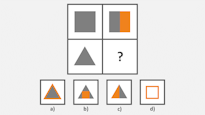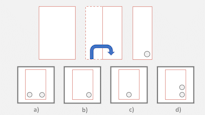How to Pass the CCAT Grade 3 Test in 2025
All products and services featured are independently selected by WikiJob. When you register or purchase through links on this page, we may earn a commission.
What Is the CCAT Test?
The Canadian Cognitive Abilities Test (CCAT) is a criteria cognitive aptitude test given every year of a child's education in Canada. It is similar to the Cognitive Abilities Test(COGAT) in the US.
Educators use the CCAT scores to identify whether a child is learning at an expected level, which is usually considered to be at the same pace as their peers.
Those who perform above average can then be placed into gifted and talented programmes in order to further their learning.
Children who perform below average can be offered extra support and learning opportunities to help them to catch up with their peers.
How Does the Grade 3 CCAT Test Differ from Tests at Other Grades?
The most significant difference of the third grade CCAT compared to previous years is that questions are no longer read aloud by the test administrator.
Instead, they will be expected to read the questions for themselves.
Picture questions will be replaced with word-based questions.
In addition, children will find the questions more challenging compared to the ones they answered in the second grade. This is because each grade’s assessment is tailored to the level of learning that they should have achieved.
Practice CCAT Test Grade 3 with JobTestPrep
What Does the CCAT Grade 3 Test Contain?
The CCAT is made up of three separate batteries of questions, each with three subsections.
Children will answer a total of 170 questions across the three batteries of assessments.
Each battery is timed, with students being allowed 30 minutes for each battery.
Educators can choose to administer the whole assessment at once, or one battery at a time.
You will be tested on numerical reasoning, verbal reasoning and critical thinking.
CCAT Grade 3 Verbal Battery
The verbal battery is designed to assess a child’s ability to read and comprehend written information.
It is made up of multiple-choice questions separated into three subsections:
- Verbal analogies
- Sentence completion
- Verbal classification
Each section has its own time limit within the overall 30 minutes.
CCAT Grade 3 Verbal Analogies
Time limit: 10 minutes
Questions in this section require that children show they understand how pairs of words are logically connected.
It is often considered to be the most challenging part of the assessment.
Example:
Cat is to kitten as dog is to BLANK
a) Calf
b) Puppy
c) Mouse
d) Lamb
CCAT Grade 3 Sentence Completion
Time limit: 10 minutes
Students are shown a series of incomplete sentences with a variety of possible words to fill the gap.
Children need to understand the meaning of the sentence before choosing the correct option.
Example:
Dad put the clothes back on the radiator because they weren’t quite BLANK.
a) Wet
b) Big
c) Green
d) Dry
CCAT Grade 3 Verbal Classification
Time limit: 10 minutes
Each question in this section presents a series of words that are connected in some way.
The challenge is to decide how the words are linked, then choose the correct answer.
Example:
How are these words connected?
Blue | Green | Orange | Purple
a) Color
b) Rainbow
c) Shape
d) Texture
CCAT Grade 3 Non-Verbal Battery
The non-verbal battery is designed to assess how well a child can use their reasoning and problem-solving skills.
The three subsections of the non-verbal battery are:
- Figure matrices
- Figure classifications
- Paper folding
This section predominantly consists of images and diagrams rather than word-based questions. All the questions are multiple-choice.
CCAT Grade 3 Figure Matrices
Time limit: 10 minutes
Children are shown a variety of images or shapes that are in some way connected.
The objective is to choose, from a selection of possible options, a shape that also fits the pattern.
Example:

Please choose the figure that fits in the '?' box.
CCAT Grade 3 Figure Classifications
Time limit: 10 minutes
The figure classification section works on a similar principle to the verbal classification section.
The pupils are shown a series of shapes that are connected by a rule. They need to choose the correct option, from a selection of choices, that describes how they fit together.
Example:

How are these shapes connected?
a) Left
b) Black
c) Straight
d) Right
CCAT Grade 3 Paper Folding
Time limit: 10 minutes
This section looks at a child's ability to use abstract thinking.
They will be shown a diagram of a folded piece of paper with a hole or holes punched in it. Dotted lines indicate where it is folded and non-colored sections indicate the hole/s.
The objective is to decide what that piece of paper would look like when it is unfolded.
Example:

Choose what the paper will look like when unfolded.

CCAT Grade 3 Quantitative Battery
Students taking the quantitative battery will be presented with a variety of number-based multiple-choice questions. These are designed to assess a child's understanding of numeracy and their mathematical skills.
The three subsections of the quantitative battery are:
- Number analogies
- Number series
- Number puzzles
CCAT Grade 3 Number Analogies
Time limit: 8 minutes
This section is similar to the verbal analogy section described above. However, rather than words, students are shown three numbers that are in some way connected.
Pupils need to decide how the numbers are connected, then choose a number that fits with the others from a series of options.
Example:
2 | 8 | 42
Choose the number that fits.
a) 3
b) 5
c) 20
d) 31
CCAT Grade 3 Number Series
Time limit: 10 minutes
Pupils are shown a series of numbers that form a pattern.
The objective is to choose a number that continues the pattern from a selection of possible options.
Example:
3, 6, 9, 12, 15, ?
Pick the number that goes next.
a) 16
b) 17
c) 18
d) 19
CCAT Grade 3 Number Puzzles
Time limit: 12 minutes
The final section in the quantitative battery involves students balancing simple equations.
They are shown a series of equations where one number is missing. Children need to fill in the gap from a selection of options.
Example:
7 x 3 = ? + 17
a) 7
b) 4
c) 9
d) 6
How Is the CCAT Grade 3 Scored?
Once students have completed the assessment and it has been marked, they will be given a selection of scores.
CCAT Grade 3 Raw Score
The raw score is the total number of correct answers given by the student. This is shown as an overall number as well as a subscore for each battery of assessments.
CCAT Grade 3 Age Percentile Rank
Students are given an age percentile rank, which compares them to children the same age. This means that all eight-year-olds will be ranked against one another, disregarding children (even in the same grade) who are younger or older.
In this ranking system, if your child is given a score of 49%, it means that they scored better than 49% of children the same age.
CCAT Grade 3 Grade Percentile Rank
The grade percentile rank looks at children within their grade. This means that all children within the third grade will be compared with one another and given a percentage, no matter whether they are the oldest in their year group or the youngest.
Within this ranking system, a score of 75% would mean that they have performed better than 75% of children within their grade.
CCAT Grade 3 Staines Rank
This is often the easiest scoring system for parents to understand. Rather than being given an overall number or percentage, students are given a score between 1 and 9.
In this system, a score between 5 and 7 is average.
1 would be considered a very low score and 9 would be exceptionally above average.
Prepare for CCAT Test Grade 3 with JobTestPrep
How to Pass the CCAT Grade 3 Test in 2025
The test is designed to assess how well a student is performing in relation to their peers, so preparation should focus on what can be done to help them feel confident ahead of the assessments and perform well on the day.
Step 1. Create a Study Schedule
While it is important to practice so that your child is comfortable with the format of the assessment and not stress about it, too much study can actually have the opposite effect.
Creating a study schedule can help your child to see that they have time to do the things that they enjoy as well as time to practice for the assessment.
It can also help to structure the time so that your child knows which aspects of the assessment they are practicing and when.
Step 2. Practice Tests
There are a number of CCAT practice tests online. Many will offer sample questions for free.
Sample tests are perfect test preparation for helping your child become familiar with the CCAT questions. They are also free practice regarding the test format and for time management.
Test practice and spending time answering the test questions on practice papers can help to identify any areas your child finds particularly challenging. This can help you to tailor your study plan to focus on improving in these areas to achieve a good score.
As well as identifying problem subjects, taking practice tests helps to familiarise your child with the different types of questions that they might find in the assessments.
If these practice tests are performed under exam conditions, such as a time limit, they also help the child learn how to work well within these constraints.
Step 3. Get Enough Sleep
Getting enough sleep) is vital for brain development.
Making sure that your child is well-rested ahead of the assessments can also help them to feel calm and relaxed about the situation.
You could help them sleep by playing calming music to drown out other noises.
Step 4. Play Games
There are many games that you can play to help build the skills your child will need for the CCAT.
Card games such as Snap are good for pattern recognition, Scrabble is useful for building spelling skills and games which involve rolling dice are good for number recognition.
Turn-taking games can also help to build communication skills. Additionally, if you let the child be in charge of the game, any game with a rulebook can be an engaging exercise for practicing their reading comprehension.
Find some games that your child enjoys playing and spend a little time each day playing together.
Step 5. Read Together
One of the most important things that a parent can ever do for their child is to share books with them. Just ten minutes a day can help to boost their vocabulary and comprehension skills.
Spend time talking about what you have read together, ask questions about the characters and discuss what you think might happen next.
It doesn’t matter whether you read to them or they read to you; both are valuable.
Step 6. Focus on the Areas Where Your Child Struggles
By using practice papers to highlight any areas which your child finds particularly challenging, you will be able to tailor your study plan to focus on improving skills in those areas.
Go beyond just doing practice questions on these problem areas and try activities that work on the same skills but in a different way.
For example, if your child struggles with the paper-folding exercises, you can include origami or paper art as part of your study plan. These skills will help to boost the knowledge they will need to improve their scores in the paper-folding section of the non-verbal battery.
Step 7. Eat a Balanced Diet
Eating well ahead of an assessment can be a relatively easy way of helping your child perform to the best of their ability. Several studies have shown that eating a balanced diet can help to boost performance during exams.
Although some children seem to have a talent for avoiding eating anything even remotely healthy, a breakfast that is high in protein and complex carbohydrates can improve focus and concentration.
Final Thoughts
As a parent, it is completely normal to feel anxious on behalf of your child before they take an assessment. You want them to do well and feel that you should do everything that you possibly can to help them.
Taking the time to practice questions in different formats can help to familiarise your child with the test. It can also help to identify any weaker areas so your child can practice and improve on them.
Simple steps in preparation for the CCAT can help your child to feel relaxed and calm, enabling them to perform to the best of their ability.






